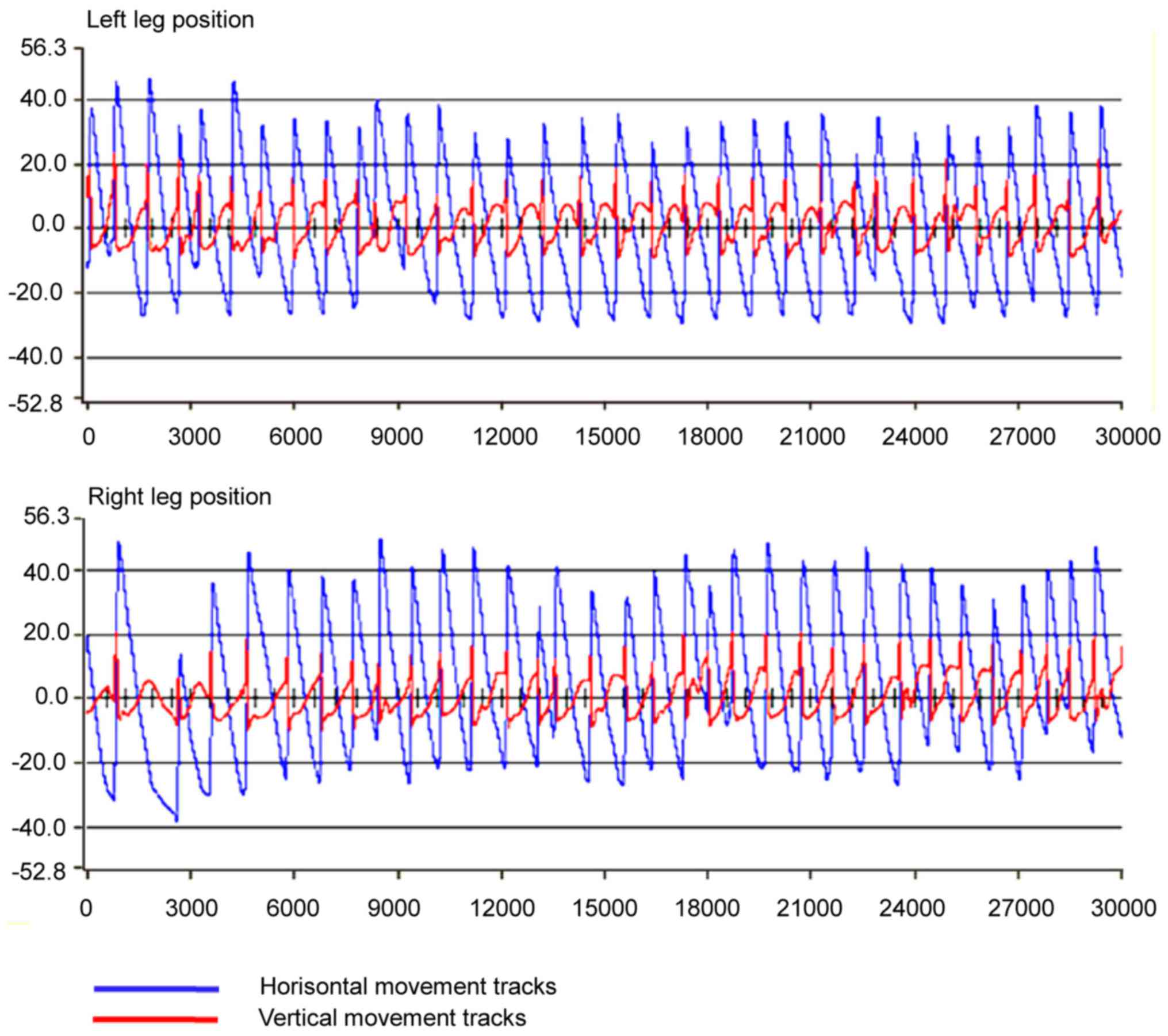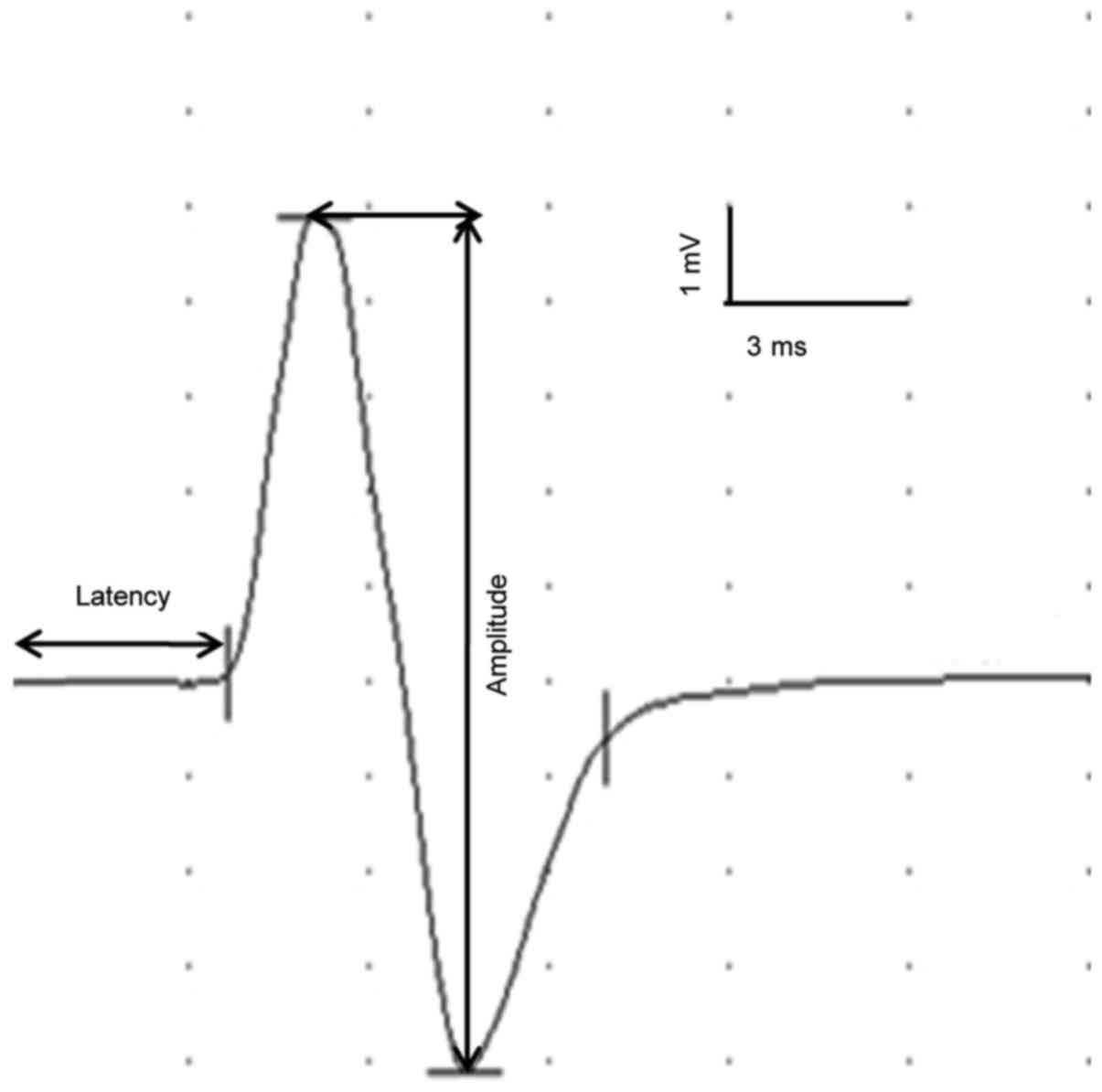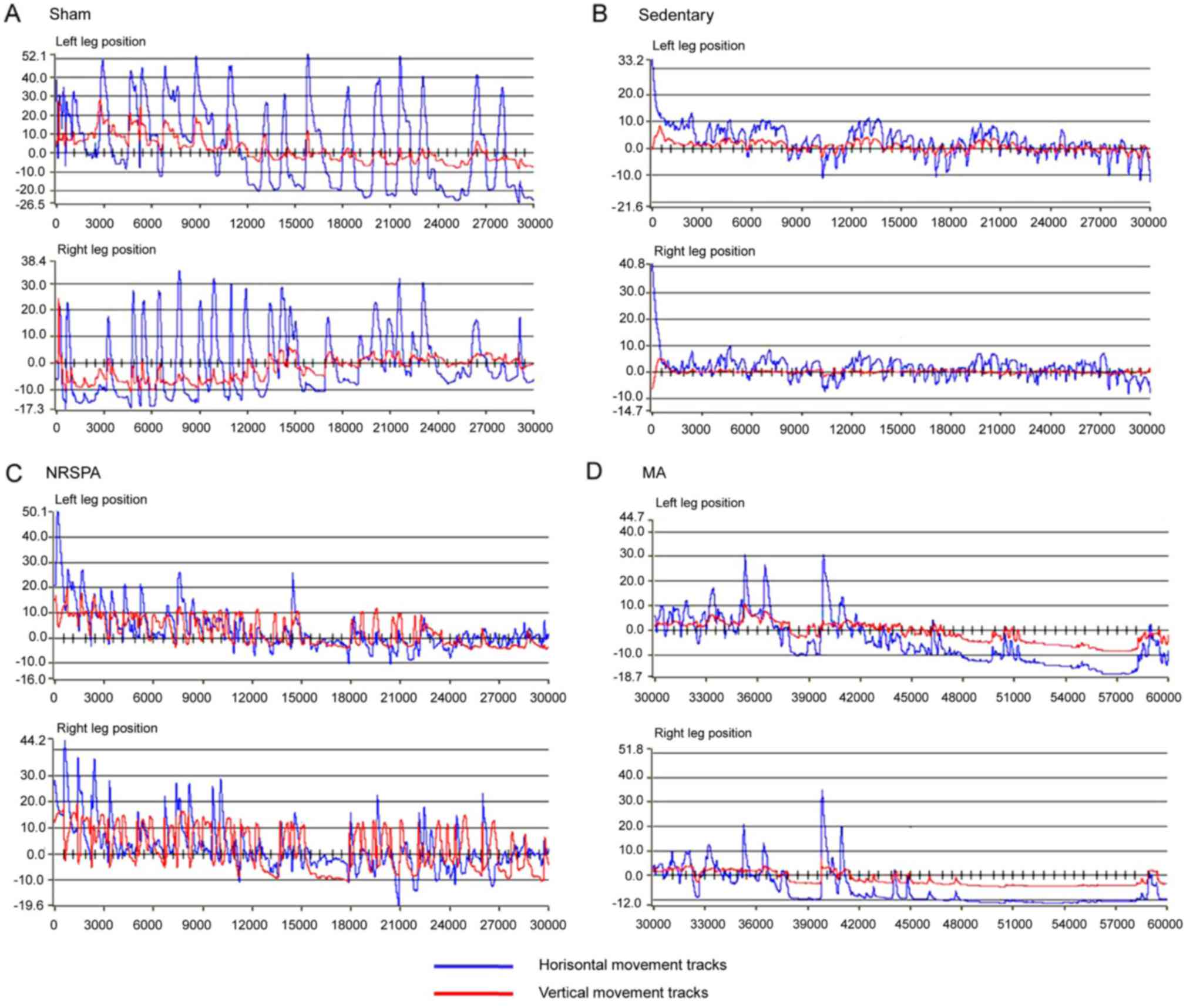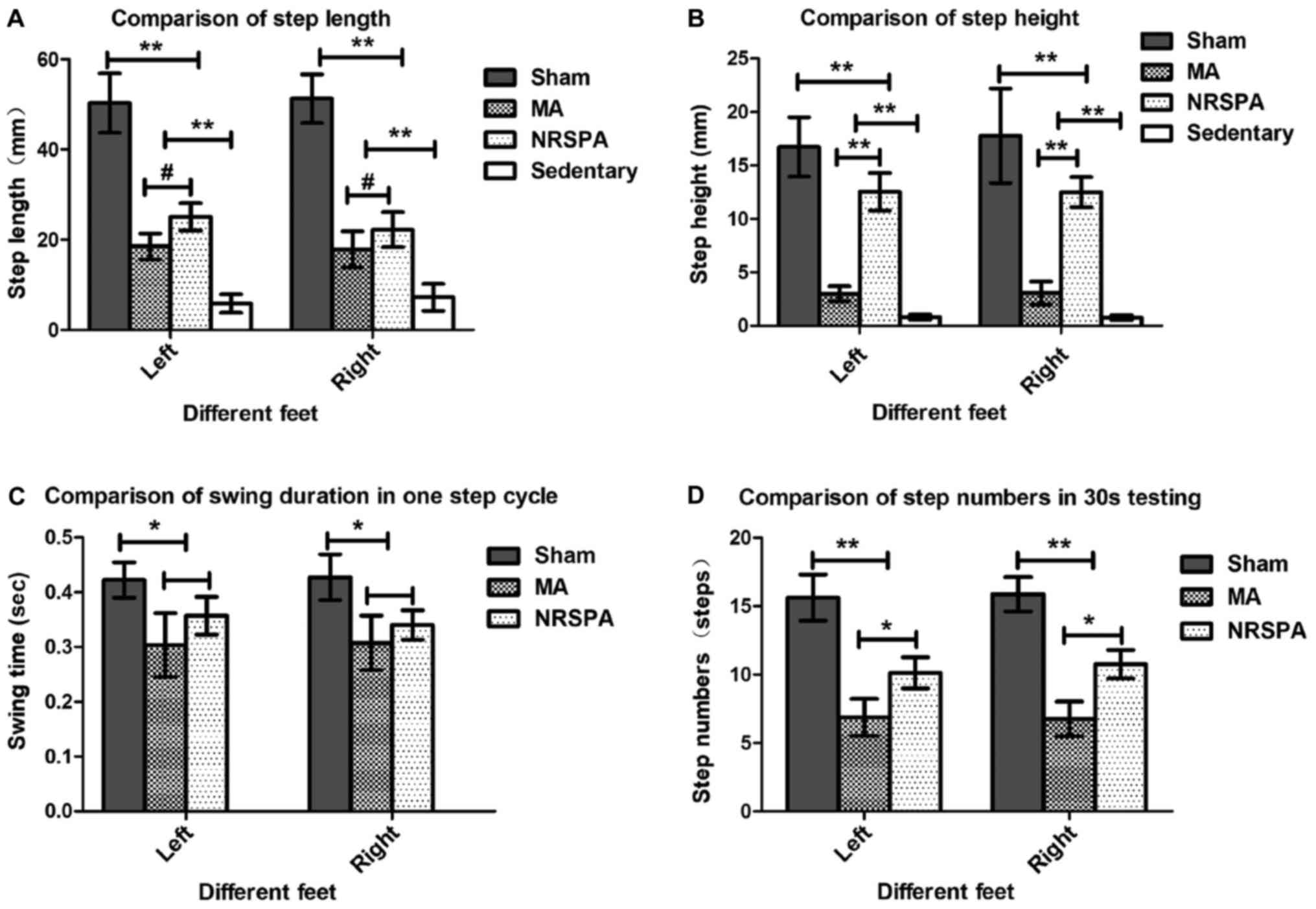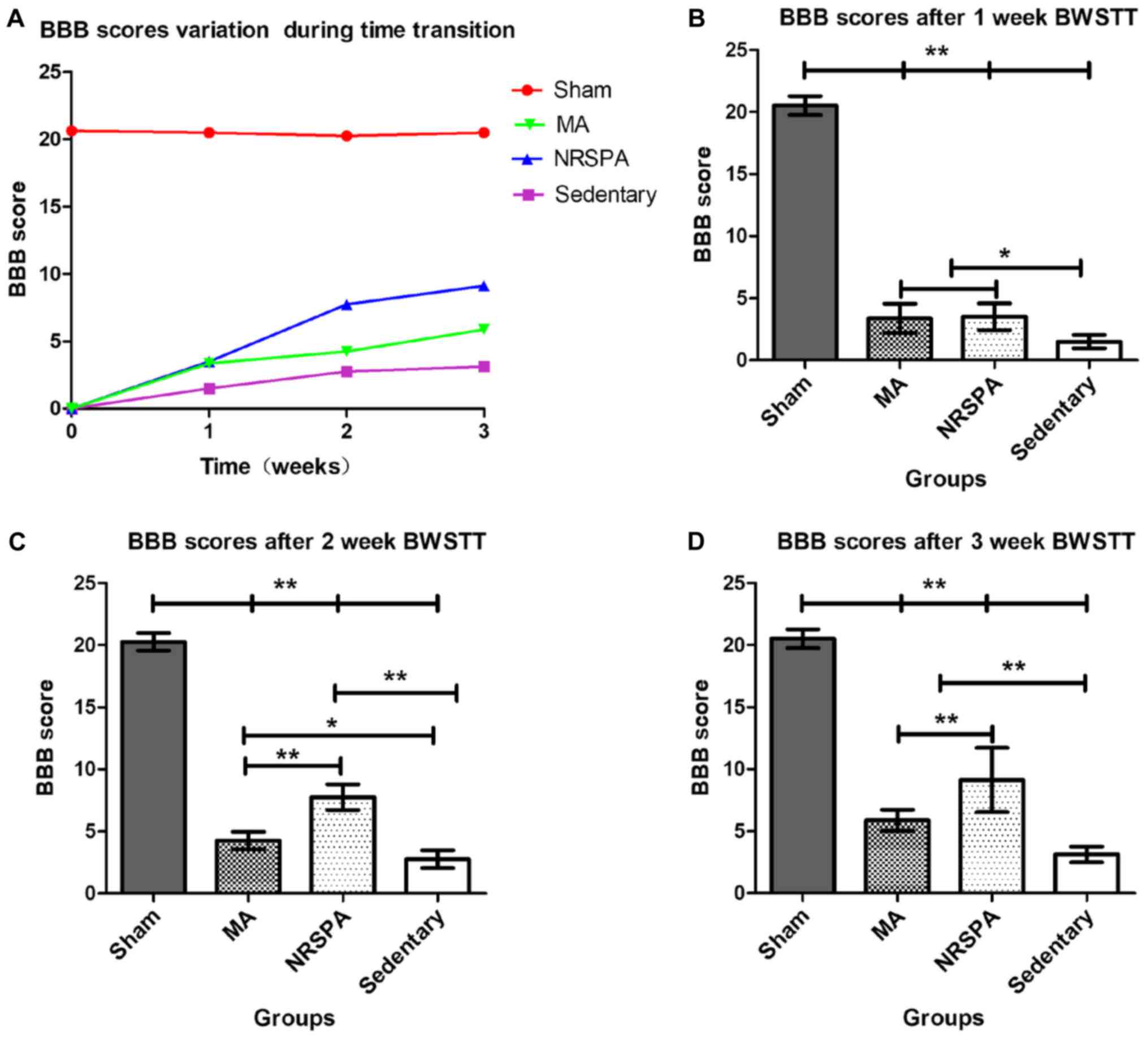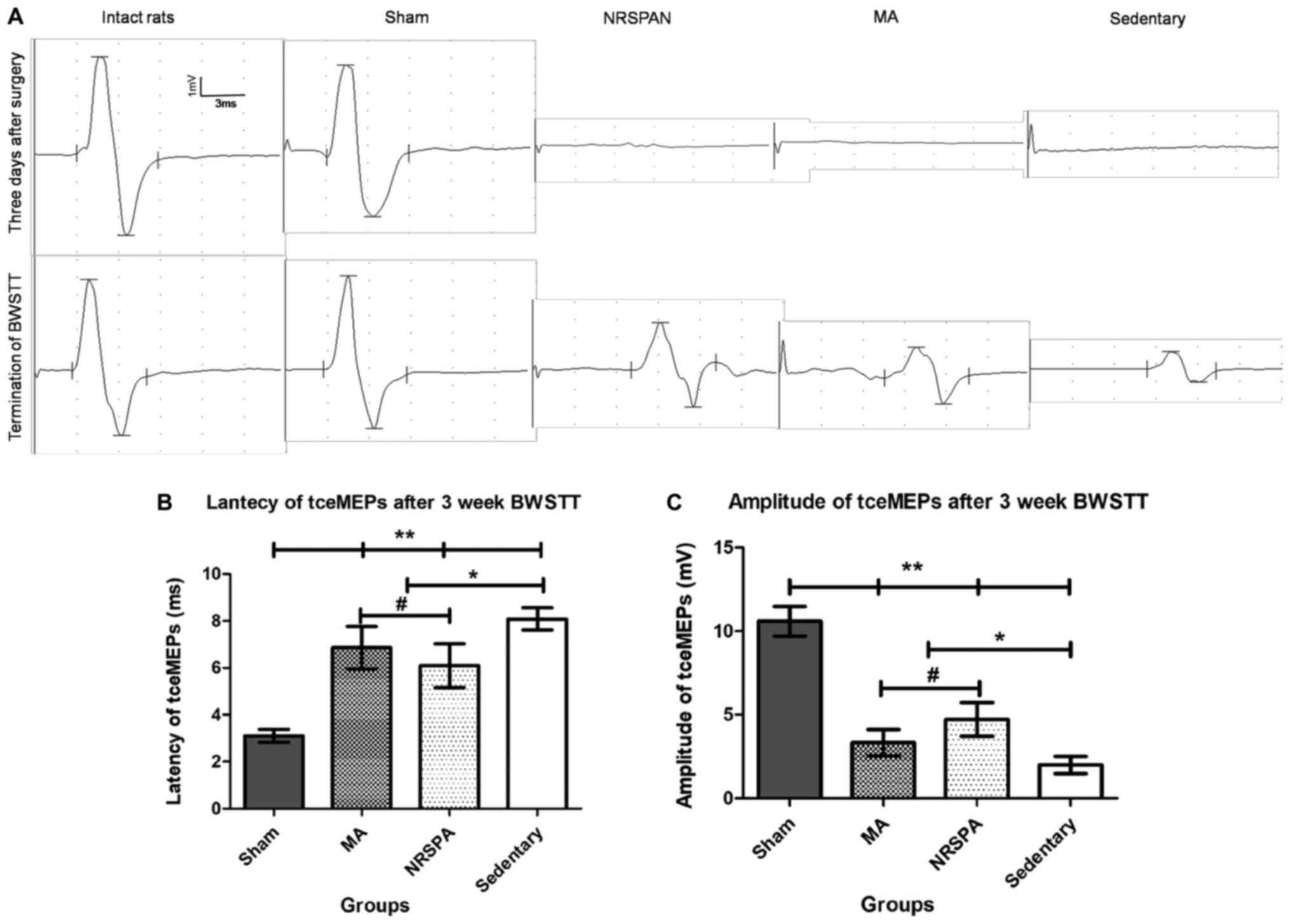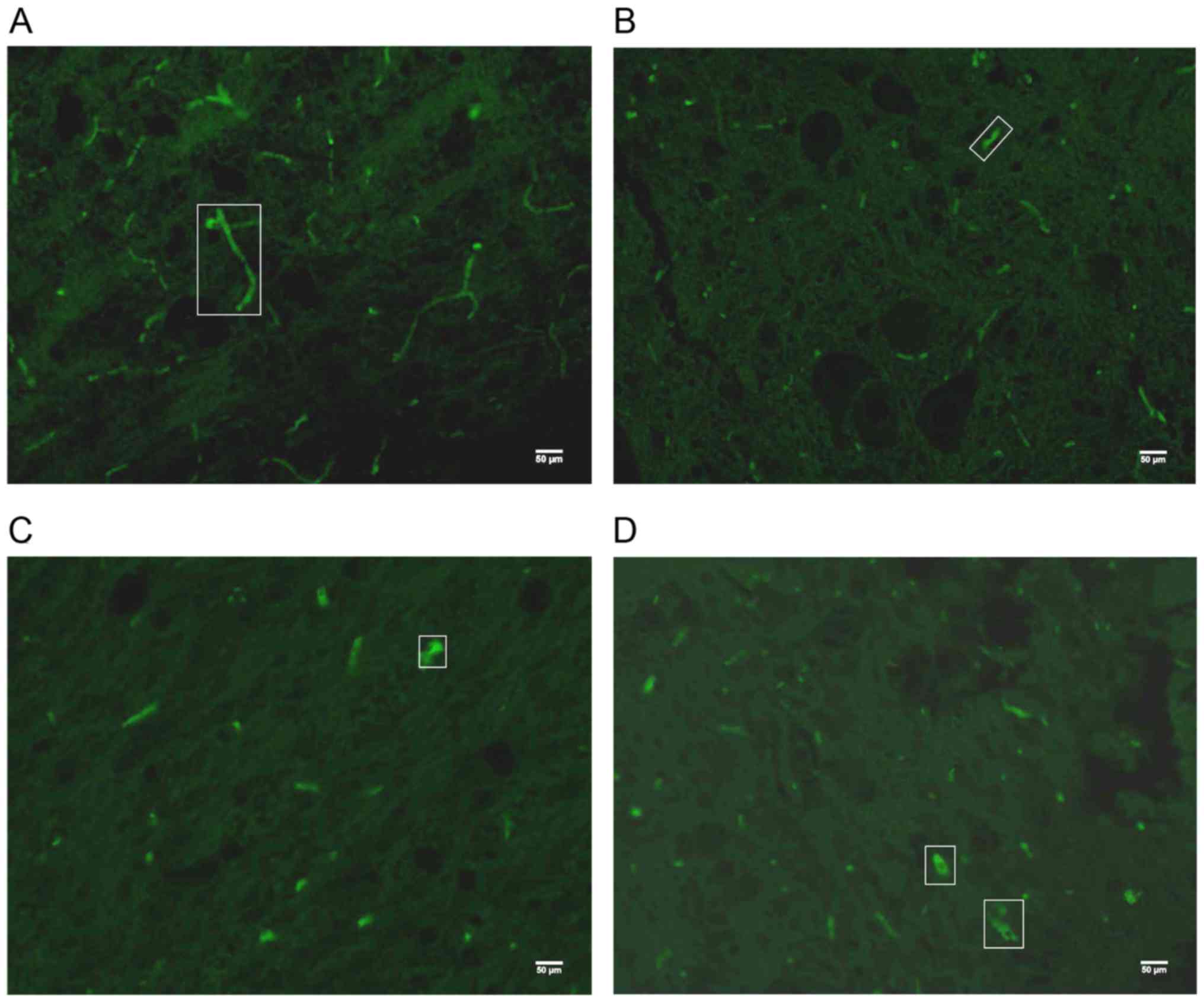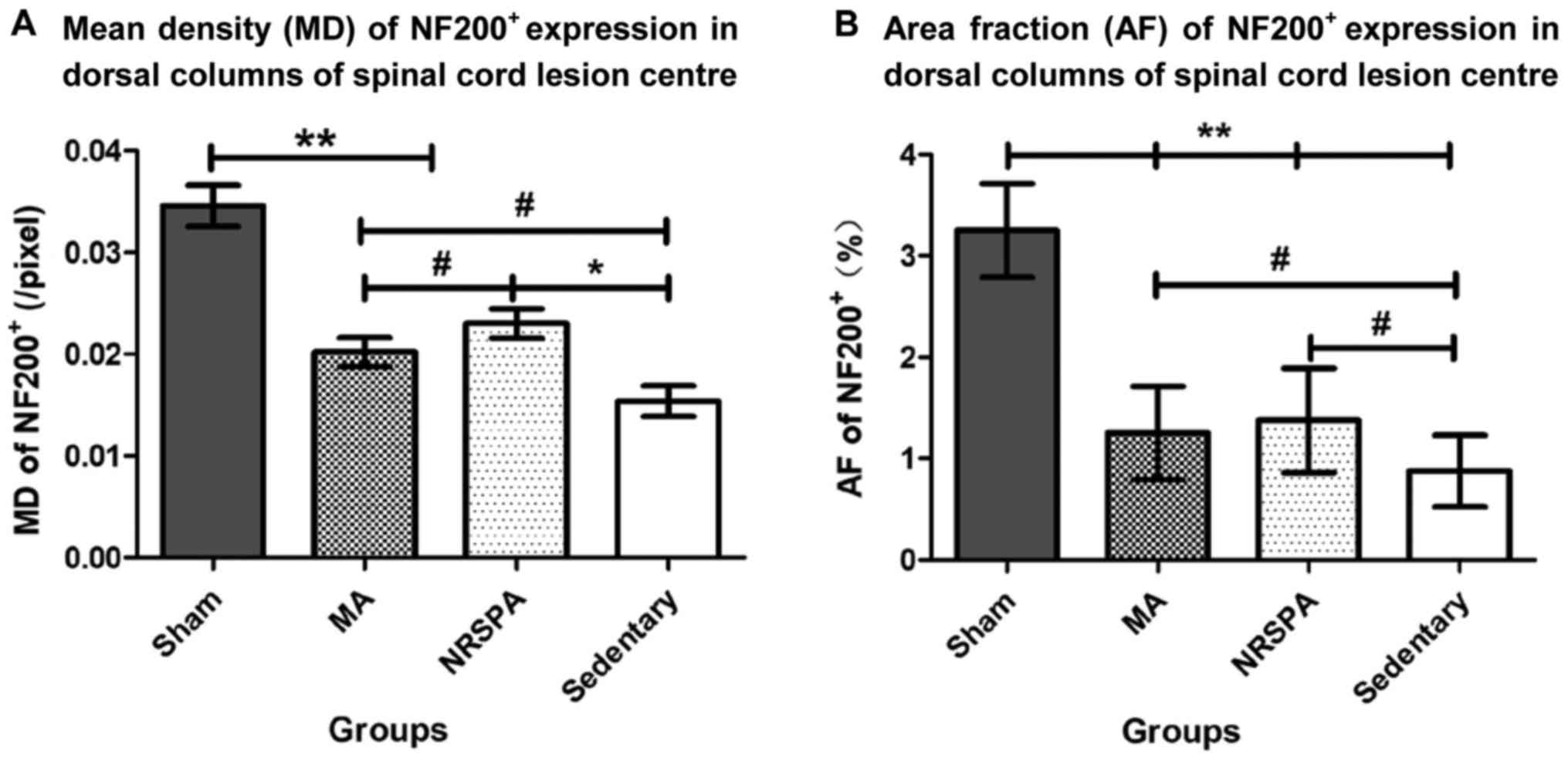|
1
|
Macias M, Dwornik A, Ziemlinska E, Fehr S,
Schachner M, Czarkowska-Bauch J and Skup M: Locomotor exercise
alters expression of pro-brain-derived neurotrophic factor,
brain-derived neurotrophic factor and its receptor TrkB in the
spinal cord of adult rats. Eur J Neurosci. 25:2425–2444. 2007.
View Article : Google Scholar : PubMed/NCBI
|
|
2
|
Macias M, Nowicka D, Czupryn A, Sulejczak
D, Skup M, Skangiel-Kramska J and Czarkowska-Bauch J:
Exercise-induced motor improvement after complete spinal cord
transection and its relation to expression of brain-derived
neurotrophic factor and presynaptic markers. BMC Neurosci.
10:1442009. View Article : Google Scholar : PubMed/NCBI
|
|
3
|
Rangasamy SB: Locomotor recovery after
spinal cord hemisection/contusion injures in bonnet monkeys:
Footprint testing-a minireview. Synapse. 67:427–453. 2013.
View Article : Google Scholar : PubMed/NCBI
|
|
4
|
Smith RR, Brown EH, Shum-Siu A, Whelan A,
Burke DA, Benton RL and Magnuson DS: Swim training initiated
acutely after spinal cord injury is ineffective and induces
extravasation in and around the epicenter. J Neurotrauma.
26:1017–1027. 2009. View Article : Google Scholar : PubMed/NCBI
|
|
5
|
Onifer SM, Zhang O, Whitnel-Smith LK, Raza
K, O'Dell CR, Lyttle TS, Rabchevsky AG, Kitzman PH and Burke DA:
Horizontal ladder task-specific re-training in adult rats with
contusive thoracic spinal cord injury. Restor Neurol Neurosci.
29:275–286. 2011.PubMed/NCBI
|
|
6
|
Côté MP, Azzam GA, Lemay MA, Zhukareva V
and Houlé JD: Activity-dependent increase in neurotrophic factors
is associated with an enhanced modulation of spinal reflexes after
spinal cord injury. J Neurotrauma. 28:299–309. 2011. View Article : Google Scholar : PubMed/NCBI
|
|
7
|
de Leon RD, See PA and Chow CH:
Differential effects of low versus high amounts of weight supported
treadmill training in spinally transected rats. J Neurotrauma.
28:1021–1033. 2011. View Article : Google Scholar : PubMed/NCBI
|
|
8
|
Watanabe S, Oya Y, Iwata J and Someya F:
Influences of changes in the level of support and walking speed on
the H Reflex of the soleus muscle and circulatory dynamics on body
weight-supported treadmill training: investigation in healthy
adults. J Phys Ther Sci. 26:1345–1350. 2014. View Article : Google Scholar : PubMed/NCBI
|
|
9
|
Lee SW, Kim YS, Jun TW, Seo JH, Kim K,
Shin MS and Kim CJ: The impact of duration of one bout treadmill
exercise on cell proliferation and central fatigue in rats. J Exerc
Rehabil. 9:463–469. 2013. View Article : Google Scholar : PubMed/NCBI
|
|
10
|
Kim YP, Kim HB, Jang MH, Lim BV, Kim YJ,
Kim H, Kim SS, Kim EH and Kim CJ: Magnitude- and time-dependence of
the effect of treadmill exercise on cell proliferation in the
dentate gyrus of rats. Int J Sports Med. 24:114–117. 2003.
View Article : Google Scholar : PubMed/NCBI
|
|
11
|
Shah PK, Gerasimenko Y, Shyu A, Lavrov I,
Zhong H, Roy RR and Edgerton VR: Variability in step training
enhances locomotor recovery after a spinal cord injury. Eur J
Neurosci. 36:2054–2062. 2012. View Article : Google Scholar : PubMed/NCBI
|
|
12
|
Navarrete-Opazo A, Alcayaga JJ, Sepúlveda
O and Varas G: Intermittent hypoxia and locomotor training enhances
dynamic but not standing balance in patients with incomplete spinal
cord injury. Arch Phys Med Rehabil. 98:415–424. 2017. View Article : Google Scholar : PubMed/NCBI
|
|
13
|
Kamgar P, Agarwal A, Chao T, Askari S, Tan
M, Honor R and Won DS: Step trajectory analysis of spinal cord
injured rats trained with neuromuscular electrical stimulation
coordinated with robotic treadmill training. Conf Proc IEEE Eng Med
Biol Soc. 2012:pp. 1864–1867. 2012; PubMed/NCBI
|
|
14
|
Scivoletto G, Tamburella F, Laurenza L,
Torre M and Molinari M: Who is going to walk? A review of the
factors influencing walking recovery after spinal cord injury.
Front Hum Neurosci. 8:1412014. View Article : Google Scholar : PubMed/NCBI
|
|
15
|
Martinez M, Delivet-Mongrain H and
Rossignol S: Treadmill training promotes spinal changes leading to
locomotor recovery after partial spinal cord injury in cats. J
Neurophysiol. 109:2909–2922. 2013. View Article : Google Scholar : PubMed/NCBI
|
|
16
|
Battistuzzo CR, Rank MM, Flynn JR, Morgan
DL, Callister R, Callister RJ and Galea MP: Effects of treadmill
training on hindlimb muscles of spinal cord-injured mice. Muscle
Nerve. 55:232–242. 2017. View Article : Google Scholar : PubMed/NCBI
|
|
17
|
Heng C and de Leon RD: Treadmill training
enhances the recovery of normal stepping patterns in spinal cord
contused rats. Exp Neurol. 216:139–147. 2009. View Article : Google Scholar : PubMed/NCBI
|
|
18
|
Yang JF, Musselman KE, Livingstone D,
Brunton K, Hendricks G, Hill D and Gorassini M: Repetitive mass
practice or focused precise practice for retraining walking after
incomplete spinal cord injury? A pilot randomized clinical trial.
Neurorehabil Neural Repair. 28:314–324. 2014. View Article : Google Scholar : PubMed/NCBI
|
|
19
|
Battistuzzo CR, Callister RJ, Callister R
and Galea MP: A systematic review of exercise training to promote
locomotor recovery in animal models of spinal cord injury. J
Neurotrauma. 29:1600–1613. 2012. View Article : Google Scholar : PubMed/NCBI
|
|
20
|
Norrie BA, Nevett-Duchcherer JM and
Gorassini MA: Reduced functional recovery by delaying motor
training after spinal cord injury. J Neurophysiol. 94:255–264.
2005. View Article : Google Scholar : PubMed/NCBI
|
|
21
|
Panisset MG, Galea MP and El-Ansary D:
Does early exercise attenuate muscle atrophy or bone loss after
spinal cord injury? Spinal Cord. 54:84–92. 2016. View Article : Google Scholar : PubMed/NCBI
|
|
22
|
Hornby TG, Zemon DH and Campbell D:
Robotic-assisted, body-weight-supported treadmill training in
individuals following motor incomplete spinal cord injury. Phys
Ther. 85:52–66. 2005.PubMed/NCBI
|
|
23
|
Gorman PH, Scott W, York H, Theyagaraj M,
Price-Miller N, McQuaid J, Eyvazzadeh M, Ivey FM and Macko RF:
Robotically assisted treadmill exercise training for improving peak
fitness in chronic motor incomplete spinal cord injury: A
randomized controlled trial. J Spinal Cord Med. 39:32–44. 2016.
View Article : Google Scholar : PubMed/NCBI
|
|
24
|
Lee C, Won D, Cantoria MJ, Hamlin M and de
Leon RD: Robotic assistance that encourages the generation of
stepping rather than fully assisting movements is best for learning
to step in spinally contused rats. J Neurophysiol. 105:2764–2771.
2011. View Article : Google Scholar : PubMed/NCBI
|
|
25
|
Aoyagi D, Ichinose WE, Harkema SJ,
Reinkensmeyer DJ and Bobrow JE: A robot and control algorithm that
can synchronously assist in naturalistic motion during
body-weight-supported gait training following neurologic injury.
IEEE Trans Neural Syst Rehabil Eng. 15:387–400. 2007. View Article : Google Scholar : PubMed/NCBI
|
|
26
|
Emken JL, Harkema SJ, Beres-Jones JA,
Ferreira CK and Reinkensmeyer DJ: Feasibility of manual
teach-and-replay and continuous impedance shaping for robotic
locomotor training following spinal cord injury. IEEE Trans Biomed
Eng. 55:322–334. 2008. View Article : Google Scholar : PubMed/NCBI
|
|
27
|
Vallery H, van Asseldonk EH, Buss M and
van der Kooij H: Reference trajectory generation for rehabilitation
robots: Complementary limb motion estimation. IEEE Trans Neural
Syst Rehabil Eng. 17:23–30. 2009. View Article : Google Scholar : PubMed/NCBI
|
|
28
|
Hornby TG, Campbell DD, Kahn JH, Demott T,
Moore JL and Roth HR: Enhanced gait-related improvements after
therapist-versus robotic-assisted locomotor training in subjects
with chronic stroke: A randomized controlled study. Stroke.
39:1786–1792. 2008. View Article : Google Scholar : PubMed/NCBI
|
|
29
|
Hussain S, Xie SQ and Liu G: Robot
assisted treadmill training: mechanisms and training strategies.
Med Eng Phys. 33:527–533. 2011. View Article : Google Scholar : PubMed/NCBI
|
|
30
|
Shah PK, Garcia-Alias G, Choe J, Gad P,
Gerasimenko Y, Tillakaratne N, Zhong H, Roy RR and Edgerton VR: Use
of quadrupedal step training to re-engage spinal interneuronal
networks and improve locomotor function after spinal cord injury.
Brain. 136:3362–3377. 2013. View Article : Google Scholar : PubMed/NCBI
|
|
31
|
Basso DM, Beattie MS and Bresnahan JC: A
sensitive and reliable locomotor rating scale for open field
testing in rats. J Neurotrauma. 12:1–21. 1995. View Article : Google Scholar : PubMed/NCBI
|
|
32
|
Wang D and Zhang J: Electrophysiological
functional recovery in a rat model of spinal cord hemisection
injury following bone marrow-derived mesenchymal stem cell
transplantation under hypothermia. Neural Regen Res. 7:749–755.
2012.PubMed/NCBI
|
|
33
|
Li WT, Zhang XY, Xue H, Ni CP, Wang EG and
An LB: Comparison of three different time points of starting
treadmill training in spinal cord injured rats. Dev Neurorehabil.
16:382–390. 2013. View Article : Google Scholar : PubMed/NCBI
|
|
34
|
Chen G, Zhang Z, Wang S and Lv D: Combined
treatment with FK506 and nerve growth factor for spinal cord injury
in rats. Exp Ther Med. 6:868–872. 2013. View Article : Google Scholar : PubMed/NCBI
|
|
35
|
Esquenazi A and Packel A: Robotic-assisted
gait training and restoration. Am J Phys Med Rehabil. 91(11 Suppl
3): S217–S231. 2012. View Article : Google Scholar : PubMed/NCBI
|
|
36
|
Shin JC, Kim JY, Park HK and Kim NY:
Effect of robotic-assisted gait training in patients with
incomplete spinal cord injury. Ann Rehabil Med. 38:719–725. 2014.
View Article : Google Scholar : PubMed/NCBI
|
|
37
|
Schwartz I and Meiner Z: Robotic-assisted
gait training in neurological patients: Who may benefit. Ann Biomed
Eng. 43:1260–1269. 2015. View Article : Google Scholar : PubMed/NCBI
|
|
38
|
Srivastava S, Kao PC, Reisman DS, Scholz
JP, Agrawal SK and Higginson JS: Robotic assist-as-needed as an
alternative to therapist-assisted gait rehabilitation. Int J Phys
Med Rehabil. 4:3702016. View Article : Google Scholar : PubMed/NCBI
|
|
39
|
Harbourne RT and Stergiou N: Movement
variability and the use of nonlinear tools: Principles to guide
physical therapist practice. Phys Ther. 89:267–282. 2009.
View Article : Google Scholar : PubMed/NCBI
|
|
40
|
Fetters L: Perspective on variability in
the development of human action. Phys Ther. 90:1860–1867. 2010.
View Article : Google Scholar : PubMed/NCBI
|
|
41
|
Bareyre FM, Kerschensteiner M, Raineteau
O, Mettenleiter TC, Weinmann O and Schwab ME: The injured spinal
cord spontaneously forms a new intraspinal circuit in adult rats.
Nat Neurosci. 7:269–277. 2004. View
Article : Google Scholar : PubMed/NCBI
|
|
42
|
Houle JD and Côté MP: Axon regeneration
and exercise-dependent plasticity after spinal cord injury. Ann N Y
Acad Sci. 1279:154–163. 2013. View Article : Google Scholar : PubMed/NCBI
|
|
43
|
Filous AR and Schwab JM: Determinants of
axon growth, plasticity and regeneration in the context of spinal
cord injury. Am J Pathol. 188:53–62. 2018. View Article : Google Scholar : PubMed/NCBI
|
|
44
|
Gossard JP, Delivet-Mongrain H, Martinez
M, Kundu A, Escalona M and Rossignol S: Plastic changes in lumbar
locomotor networks after a partial spinal cord injury in cats. J
Neurosci. 35:9446–9455. 2015. View Article : Google Scholar : PubMed/NCBI
|
|
45
|
Martinez M, Delivet-Mongrain H, Leblond H
and Rossignol S: Incomplete spinal cord injury promotes durable
functional changes within the spinal locomotor circuitry. J
Neurophysiol. 108:124–134. 2012. View Article : Google Scholar : PubMed/NCBI
|
|
46
|
Adkins DL, Boychuk J, Remple MS and Kleim
JA: Motor training induces experience-specific patterns of
plasticity across motor cortex and spinal cord. J Appl Physiol
(1985). 101:1776–1782. 2006. View Article : Google Scholar : PubMed/NCBI
|
|
47
|
Rossignol S and Frigon A: Recovery of
locomotion after spinal cord injury: Some facts and mechanisms.
Annu Rev Neurosci. 34:413–440. 2011. View Article : Google Scholar : PubMed/NCBI
|
|
48
|
Liu GT, Ferguson AR, Crown ED, Bopp AC,
Miranda RC and Grau JW: Instrumental learning within the rat spinal
cord: Localization of the essential neural circuit. Behav Neurosci.
119:538–547. 2005. View Article : Google Scholar : PubMed/NCBI
|
|
49
|
Morris SH, Howard JJ, Rasmusson DD and
El-Hawary R: Validity of transcranial motor evoked potentials as
early indicators of neural compromise in rat model of spinal cord
compression. Spine (Phila Pa 1976). 40:E492–E497. 2015. View Article : Google Scholar : PubMed/NCBI
|
|
50
|
Alam M, Garcia-Alias G, Shah PK,
Gerasimenko Y, Zhong H, Roy RR and Edgerton VR: Evaluation of
optimal electrode configurations for epidural spinal cord
stimulation in cervical spinal cord injured rats. J Neurosci
Methods. 247:50–57. 2015. View Article : Google Scholar : PubMed/NCBI
|
|
51
|
Petersen JA, Spiess M, Curt A, Dietz V and
Schubert M; EM-SCI Study Group, : Spinal cord injury: One-year
evolution of motor-evoked potentials and recovery of leg motor
function in 255 patients. Neurorehabil Neural Repair. 26:939–948.
2012. View Article : Google Scholar : PubMed/NCBI
|



